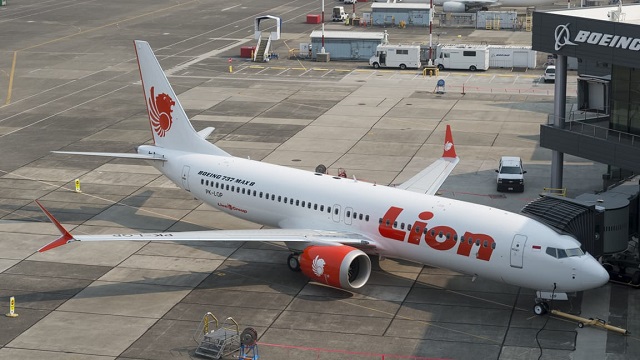
Jakarta, Indonesia | AFP | Boeing issued a special bulletin Wednesday addressing a sensor problem flagged by Indonesian safety officials investigating the crash of a Lion Air 737 that killed 189 people last week.
The plane maker said local aviation officials believed pilots might have been given wrong information by the plane’s automated systems before the fatal crash.
“The Indonesian National Transportation Safety Committee has indicated that Lion Air flight 610 experienced erroneous input from one of its AOA (Angle of Attack) sensors,” Boeing said.
“Boeing issued an Operations Manual Bulletin (OMB) directing operators to existing flight crew procedures to address circumstances where there is erroneous input from an AOA sensor.”
The US Federal Aviation Administration issued an order to domestic carriers to follow the new instructions on dealing with the erroneous sensor alert in 737-8 and -9 airplanes.
This affects nearly 250 aircraft flown by US airlines like Southwest, American and United, the FAA said.
The FAA emergency directive warns that the “erroneous inputs can potentially make the horizontal stabilizers repeatedly pitch the nose of the airplane downward, making the aircraft difficult to control.”
An AOA sensor provides data about the angle at which wind is passing over the wings and tells pilots how much lift a plane is getting. The information can be critical in preventing the plane from stalling.
Lion Air JT610 plunged into the Java Sea less than half an hour after taking off from Jakarta on a routine flight to Pangkal Pinang city. There were no survivors.
The doomed jet was a Boeing 737-Max 8, one of the world’s newest and most advanced commercial passenger planes, and there is still no answer as to what caused the crash. A preliminary report is expected at the end of the month.
– Instrument failure? –
Indonesian investigators said Wednesday the plane had experienced instrument failures on four flights, including on one journey where both the AOA sensor and the airspeed indicator were affected.
Soerjanto Tjahjono, head of Indonesia’s National Transportation Safety Committee told reporters that after one flight from Bali to Jakarta — the last flight before the crash — the left and right AOA sensors were found to disagree by 20 degrees.
He said the pilot had landed the plane safely on that occasion.
“The pilot’s success became our reference to give a recommendation to Boeing so they could issue an advice for other airlines to follow the same procedures if the same situation occurs,” Soerjanto said.
He added that the broken sensor from the Bali-Jakarta flight would be sent to the manufacturer in Chicago for further examination.
“We also plan to conduct a flight reconstruction to see the impact of the AOA sensor damage in the engineering simulator at the Boeing facility in Seattle.”
Search teams combing the wreckage of JT610 have filled 186 body bags with remains but only 44 victims have been identified so far.
Indonesian officials said on Wednesday they would extend the search by three days.
Divers have recovered one of the two “black boxes” — the flight data recorder — but are still looking for the cockpit voice recorder, in the hope it will shed more light on the cause of the accident.
The accident has resurrected concerns about Indonesia’s poor air safety record, which until recently saw its carriers facing years-long bans from entering European Union and US airspace.
Boeing Statement on Operations Manual Bulletin: https://t.co/5e18xbb4uX
— Boeing Airplanes (@BoeingAirplanes) November 7, 2018
 The Independent Uganda: You get the Truth we Pay the Price
The Independent Uganda: You get the Truth we Pay the Price



